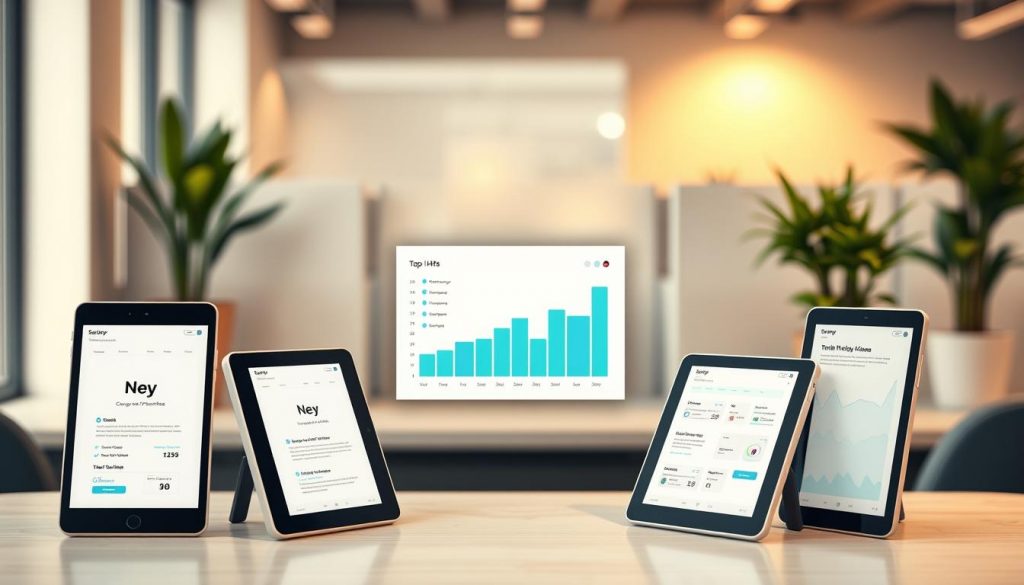In today’s fast-paced world, picking the right HR software is key for smooth operations. A good human resources management system makes things easier, improves work life, and helps your business grow.
Finding the perfect HR solution can be tough with so many choices. This article will help you navigate this, focusing on the best HR software features and benefits.
Knowing what HR software can do and matching it to your business needs is important. This choice can boost your HR work and help your company succeed.
Key Takeaways
- Understand the importance of HR software in modern business.
- Identify key features to look for in HR software.
- Explore top HR software solutions and their pricing plans.
- Learn how to align HR software with your business needs.
- Discover the benefits of implementing the right HR solution.
Understanding HR Software and Its Importance
Businesses today face many challenges in managing their workforce. HR software, or Human Resource Management System (HRMS), is key to solving these issues. It helps manage and improve HR processes, making it essential for all businesses.
What is HR Software?
HR software is a platform that handles many HR tasks. It includes employee data management, payroll processing, benefits administration, time tracking, and performance evaluation. It automates these tasks, reducing workloads, errors, and improving HR efficiency.
The Evolution of HR Technology in Recent Years
HR technology has changed a lot in the last ten years. It has moved from simple tools to advanced employee management software. Now, it uses artificial intelligence (AI) and machine learning (ML) to forecast trends, improve hiring, and boost employee engagement.
Why Your Business Needs HR Software in 2025
In 2025, having the right HR software is vital, not just an advantage. With remote work, global hiring, and changing workforce, businesses need strong HR tools. Here’s a table showing the benefits of HR software:
| Feature | Manual Process | HR Software |
|---|---|---|
| Employee Data Management | Error-prone, time-consuming | Accurate, automated |
| Payroll Processing | Labor-intensive, prone to errors | Streamlined, compliant |
| Performance Evaluation | Subjective, infrequent | Data-driven, continuous |
HR software helps businesses streamline their HR tasks. It also gives insights into their workforce. This information helps make decisions that lead to growth and success.
Key Benefits of HR Software for Your Business
HR software can change how your business works. It makes HR tasks easier and more efficient. This is key in today’s fast-paced business world, where companies are always looking to do better and make their employees happier.
Streamlining HR Processes and Reducing Administrative Burden
HR software automates tasks like payroll, leave, and employee data. This lets HR teams focus on big-picture tasks instead of day-to-day work.
For example, it makes tracking leave easier and less prone to mistakes. This saves time and makes employees happier with a more reliable HR service.
Improving Employee Experience and Engagement
HR software gives employees a self-service portal. They can check their data, request time off, and take training. This makes them feel more in control and engaged.
It also helps employees and managers talk better. This creates a more open and caring work place.
Data-Driven Decision Making with HR Analytics
HR software gives insights into how your team is doing. This helps you make smart choices. You can spot areas to get better, plan your team better, and manage talent well.
Cost Savings and ROI of HR Software Solutions
HR software saves money by cutting down on manual work and mistakes. It also helps avoid big fines for not following rules.
Here’s a table showing how HR software can save money:
| HR Software Feature | Manual Process | HR Software |
|---|---|---|
| Payroll Processing | $5,000 per month | $1,000 per month |
| Leave Management | 10 hours per week | 2 hours per week |
| Employee Data Management | High error rate | Low error rate |
As the table shows, HR software can save a lot of money. It automates tasks and gives insights, helping businesses run better and save money.
Essential Features to Look for in HR Software for Your Business
Understanding the features of HR software is key to getting the most out of it. As businesses grow, the right HR software can greatly help manage HR tasks.
Core HR Management Capabilities
At the core of HR software are its core HR management features. These include managing employee data, tracking time off, and handling benefits. Effective core HR management helps keep records accurate, cuts down on paperwork, and ensures rules are followed.
Recruitment and Onboarding Tools
Streamlining hiring is a must for HR software. Look for tools with applicant tracking systems (ATS), automated job postings, and candidate management. Onboarding tools also help new employees fit in better, making their experience positive.
Performance Management Features
Performance management is key to HR. Look for software with goal setting and tracking, regular feedback, and appraisal tools. These features foster a culture of growth and employee development.
Learning and Development Modules
Investing in employee growth is vital for business success. HR software with learning and development modules offers training for employees to do well. Look for tools that let you create courses, manage enrollments, and track progress.
Employee Self-Service Portals
Employee self-service portals give staff access to their data, benefits, and time-off requests. This boosts employee happiness and lightens the HR team’s workload.
When looking at HR software, focus on these key features:
- Core HR management capabilities
- Recruitment and onboarding tools
- Performance management features
- Learning and development modules
- Employee self-service portals
By focusing on these features, businesses can find an HR software that fits their needs and supports their growth.
Types of HR Software for Your Business
It’s important to know the different HR software types for your business. Each type meets different needs. Exploring the HR software landscape is key.
All-in-One Human Resources Management Systems
All-in-one HR systems have many tools for various HR tasks. They help with recruitment, onboarding, performance management, and more. These systems make HR work easier and reduce paperwork.
“An all-in-one HR system can really boost your business,” says HR expert John Smith.
“It’s a game-changer for businesses looking to simplify their HR processes and focus on strategic growth.”
Specialized HR Tools
Specialized HR tools focus on specific areas like recruitment or performance management. They’re great for businesses needing advanced features in certain areas. Or for those who prefer the best tools for each task.
Cloud-Based vs. On-Premise HR Software
Choosing between cloud-based and on-premise HR software is important. Cloud-based software is flexible and accessible from anywhere. On-premise solutions offer better data security and customization. Think about what your business needs most.
- Cloud-based HR software offers automatic updates and reduced IT burden.
- On-premise HR software provides enhanced data security and control.
Small Business HR Software vs. Enterprise Solutions
The size of your business affects your HR software choice. Small business software is simpler and more affordable. It’s for smaller teams and less complex needs. Enterprise solutions are more powerful for bigger teams and complex structures.
Consider scalability, user needs, and budget when choosing.
Assessing Your Business Needs Before Choosing HR Software
Before you start looking at HR software, it’s key to know what your business needs. This helps make sure the software you pick fits your goals and problems.
Evaluating Your Current HR Challenges
First, look at what’s not working well in your HR area. Find out where your processes are slow or hard to do. Issues like manual data entry, not seeing how employees are doing, and keeping up with rules are common.
Identifying Must-Have Features for Your Organization
Then, figure out what features you really need. Think about the basic HR stuff, tools for hiring and starting new employees, ways to track performance, and places for employees to help themselves.
- Core HR management
- Recruitment and onboarding tools
- Performance management features
- Employee self-service portals
Considering Company Size and Growth Plans
Don’t forget about your company’s size and how it’s growing. Scalability is important. Make sure the software can grow with you, changing as your needs do.
Budget Considerations for HR Software Investment
Lastly, think about your budget for HR software. Look at all costs, like setup fees, monthly payments, and extra charges for help or training. A smart budget helps you find software that fits your needs without costing too much.
By carefully looking at your business needs, you can choose HR software that really works for your company.
Top 5 HR Software Solutions for Your Business in 2025
The world of HR technology is changing fast. Finding the best HR software for 2025 is key for success. Companies need the latest and most integrated HR solutions to improve their HR processes.
Comparison Table of Leading HR Software Options
We’ve made a table to help you choose. It compares the top 5 HR software: BambooHR, Workday, Gusto, Rippling, and ADP Workforce Now.
| HR Software | Core Features | Pricing Plans | Best For |
|---|---|---|---|
| BambooHR | HR management, time tracking, reporting | $99-$149/month | Small to medium businesses |
| Workday | HR management, payroll, financial planning | Custom pricing | Large enterprises |
| Gusto | Payroll processing, benefits administration, compliance | $6-$12/employee/month | Businesses with 2-1000 employees |
| Rippling | HR, IT, finance management | $8-$15/employee/month | Growing businesses |
| ADP Workforce Now | HR, payroll, time tracking, benefits | Custom pricing | Medium to large businesses |
Features Comparison
Each HR software has special features to make HR easier. BambooHR is great for HR management and reporting. Workday is known for its HR and financial planning.
Pricing Plans Breakdown
Pricing changes a lot among these options. Gusto and Rippling charge based on employees. BambooHR and ADP Workforce Now have tiered plans. Workday’s pricing is custom for big companies.

BambooHR: Best for Small to Medium Businesses
BambooHR is great for small to medium businesses. It’s easy to use and has lots of HR features.
Workday: Enterprise-Grade HR Software Solution
Workday is for big companies. It has advanced HR, payroll, and financial planning for complex needs.
Gusto: Ideal for Payroll and Benefits Administration
Gusto is known for its payroll and benefits features. It’s perfect for businesses that want to simplify these tasks.
Rippling: All-in-One HR, IT, and Finance Platform
Rippling is a complete platform for HR, IT, and finance. It’s great for growing businesses that need everything in one place.
ADP Workforce Now: Comprehensive HR Management System
ADP Workforce Now has lots of features for HR, payroll, time tracking, and benefits. It’s good for medium to large businesses.
By looking at these top HR software options, businesses can pick the best employee management software for 2025.
Evaluating HR Software Vendors and Security
Choosing the right HR software vendor is key to keeping your HR processes safe and efficient. As you explore different HR software solutions, it’s important to check more than just the features. You should also look at the vendor’s trustworthiness and reliability.
Vendor Reputation and Customer Support
A vendor’s reputation shows the quality of their HR software. Look for vendors known for reliable services and great customer support. Check how well they answer questions, offer training, and how happy their current clients are.
Data Security and Compliance Features
Keeping employee data safe is a top priority. Make sure the HR software you pick has strong security features. Look for data encryption, secure access, and regular security checks. It’s also important that the software follows laws like GDPR and CCPA.
Service Level Agreements and Uptime Guarantees
Service Level Agreements (SLAs) tell you what to expect from the service. They cover uptime and how fast support will respond. When looking at small business HR software or bigger solutions, check the vendor’s uptime promises and how they handle problems.
User Reviews and Industry Ratings
User feedback and industry ratings give you a true picture of HR software solutions. Look for comments on customer support, how easy the software is to use, and any downsides. This helps you make a better choice.
| Vendor | Reputation Score | Security Features | Customer Support Rating |
|---|---|---|---|
| BambooHR | 4.5/5 | Data Encryption, 2FA | 4.7/5 |
| Workday | 4.3/5 | Advanced Encryption, Compliance Certifications | 4.5/5 |
| Gusto | 4.8/5 | Secure Data Centers, Regular Audits | 4.9/5 |
Implementation and Integration of HR Software
To get the most out of HR software, businesses need to tackle the challenges of setup and integration. A well-thought-out rollout is key to unlocking the HR software benefits and making the transition smooth.
Planning Your HR Software Deployment
Good planning starts with understanding your company’s unique needs. It’s important to pick the right cloud-based HR software that fits your goals.
Data Migration Strategies
Moving data to new HR software is a big part of the process. You need a plan that keeps your data safe and accurate during the move.
| Data Type | Migration Strategy | Considerations |
|---|---|---|
| Employee Records | Manual Entry or CSV Import | Data Accuracy, Security |
| Payroll Data | Integration with Payroll Systems | Compatibility, Data Mapping |
Training Your Team on New HR Software
Teaching your HR team how to use the new software is critical. They need to know how to get the most out of it.
“The key to successful HR software implementation is not just about the technology itself, but also about how well your team can use it.” – HR Expert
Connecting with Existing Business Systems
Linking your HR software with other business systems is key. This ensures data flows smoothly between departments.

Measuring Implementation Success
To see if your HR software rollout was a success, set clear goals. Look at how well users are adopting it, data quality, and its impact on HR tasks.
With careful planning and execution, you can make your HR software integration a success. This will boost your company’s efficiency and productivity.
Conclusion: Making the Final Decision on HR Software for Your Business
Choosing the right HR software is key to your business’s success in 2025. It’s important to know what HR software features you need. This way, you can make a choice that fits your business well.
When picking hr software for your business, look at the features that match your goals. These include managing HR, finding new employees, and tracking performance.
Top HR software like BambooHR, Workday, and Gusto have many useful features. They can make HR tasks easier, improve how employees feel, and help you make better decisions with data. Look at what each vendor offers, their reputation, how they keep data safe, and their customer support. This will help you find the best HR software for your business.
In the end, the right HR software can help you reach your business goals. It can make your operations more efficient and help your business grow. Take your time to look at all your options. Choose the one that fits your business strategy best.



Had a bit of luck on 123win94.net! Not life-changing, but enough to keep me coming back. They seem legit and it’s a fun place to unwind after work. Try it 123win94 yourself and tell me what you think!